MARIANI’S
December
6, 2009
NEWSLETTER
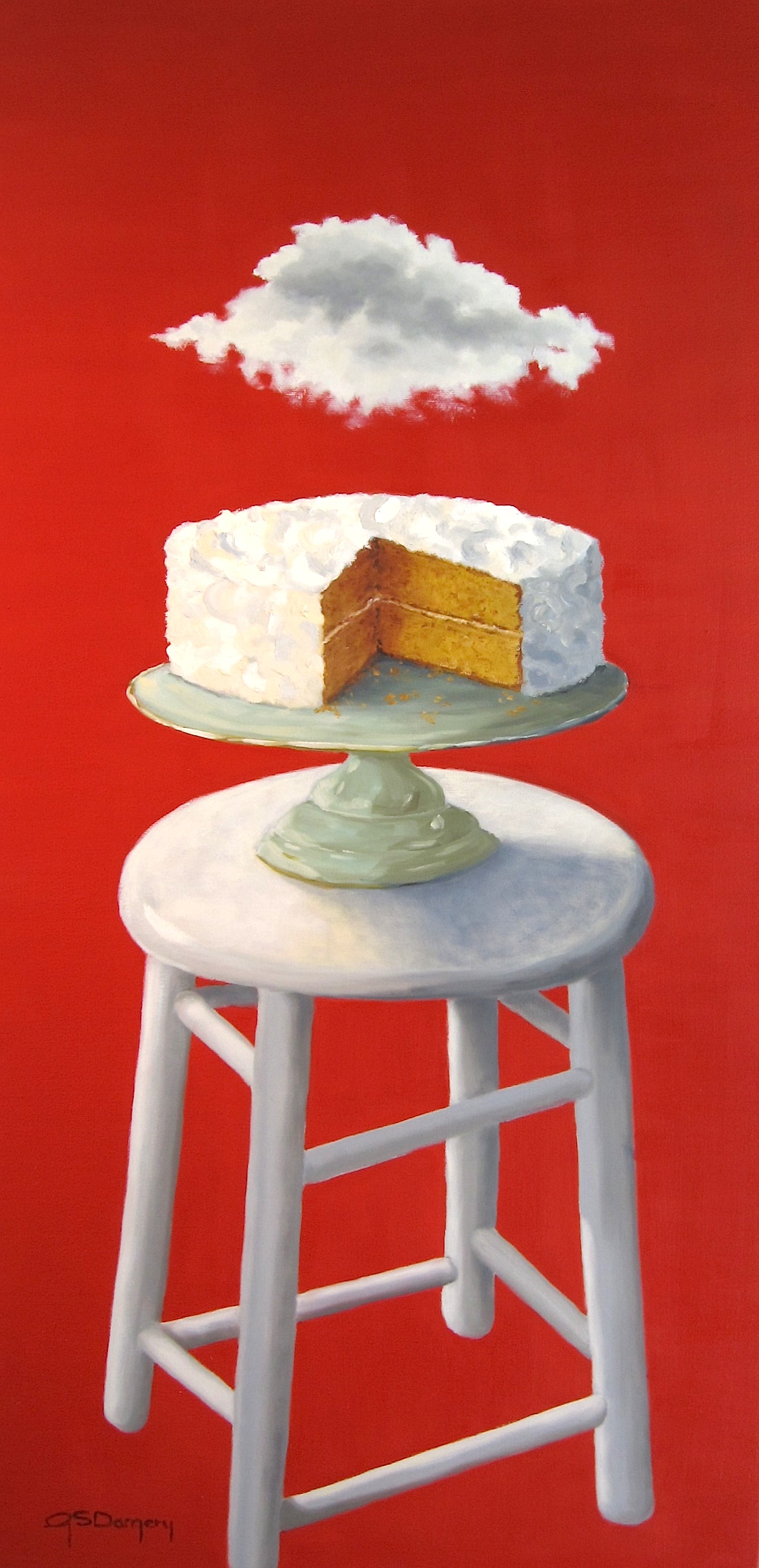
"Angel Cake" (2009)
by Galina Stepanoff-Dargery
➔ QUESTIONS? TO REACH JOHN MARIANI WRITE TO: newsletter@johnmariani.com.
➔ ARCHIVE: Readers may now access an Archive of all past newsletters--each annotated--dating back to July, 2003, by simply clicking on www.johnmariani.com/archive
➔ SUBSCRIBE AND UN-SUBSCRIBE: You may subscribe anyone you wish to this newsletter--free of charge--by clicking here.
~~~~~~~~~~~~~
☛ In
This Issue
NEW YORK CORNER: A Voce, Part Due by John Mariani
NOTES FROM
THE WINE
CELLAR: A HARLAN DINNER FOR THE AGES
by Brian A. Freedman
~~~~~~~~~~~~~
LA VEGAS: WYNN WINS AGAIN
By John Mariani
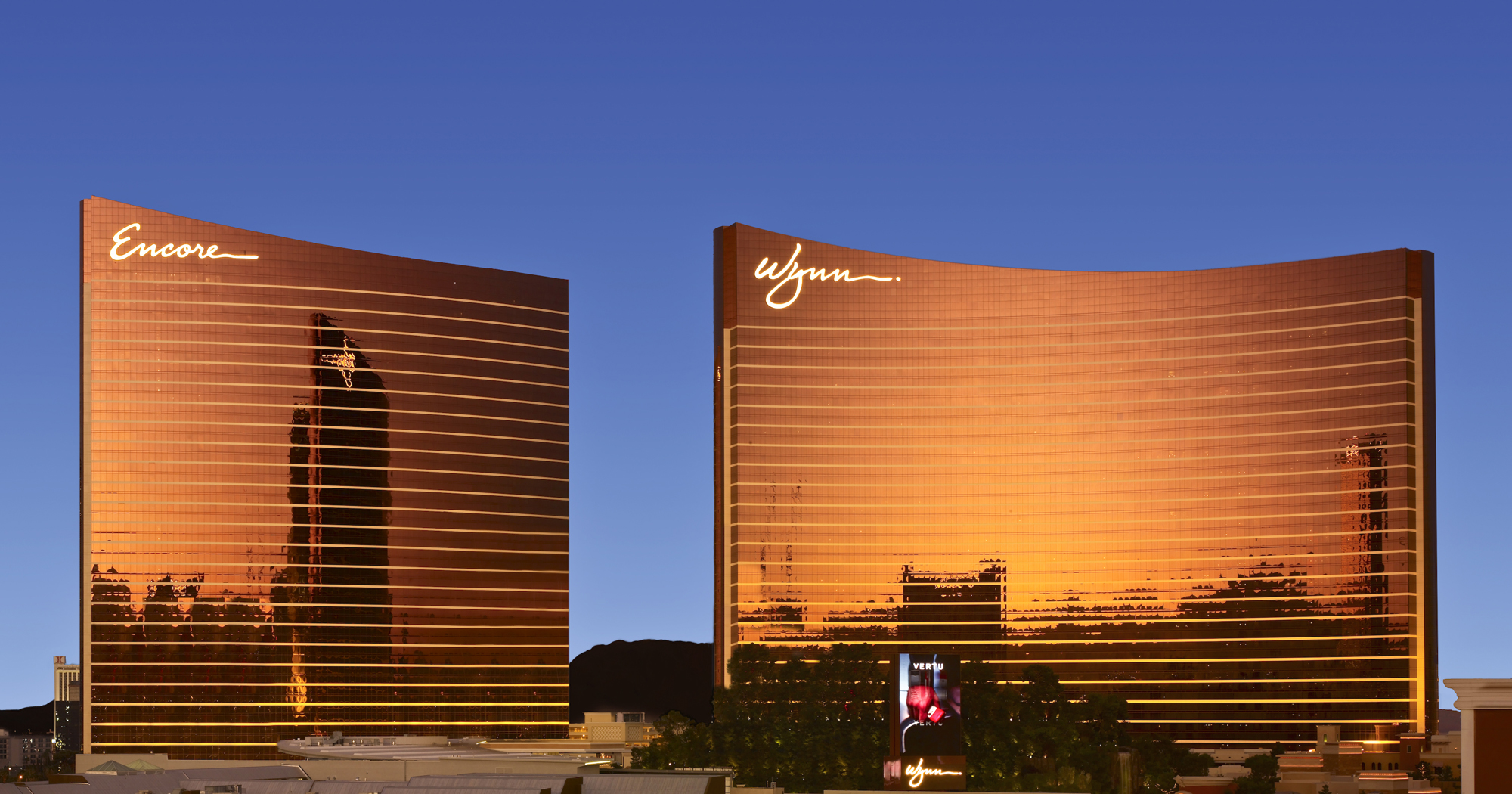
Las
Vegas boosters will be the
first to
tell you that their city now has some of the finest restaurants in the
world, and they’re right—with one difference. In most cases, those
restaurants are branches of originals from elsewhere, including Paris,
New York, Chicago, and Los Angeles. But in a city of smoke and
mirrors and Elvis impersonators, what can you believe?
To my mind, much of the hype has plenty of
ballast. Las Vegas does now possess some of the great restaurants
in America, with some of the most famous chefs’ names on the
doors. In many cases, however, celebrity chefs in Vegas run
plenty of mediocre restaurants with very little input of presence from
the marquee names that suggest they are in town cooking for you.
In fact, if you come down the escalator of
McCarran Airport when you arrive, you’ll see a huge sign with Wolfgang
Puck’s smiling face on it and he is dressed in chef’s whites; the sign
reads, “Less Celebrity, More Chef,” indicating that Puck will in fact
be in the kitchen cooking at all six of his Vegas restaurants. Don’t
bet on it.
This kind of hype was a great part of the
first wave of new restaurants opening in Vegas a decade ago, with name
chefs given management contracts and lots of money to put their names
and not much else on restaurants. Some, like Puck’s own Spago,
Jean-Georges Vongerichten’s Prime, Piero Selvaggio’s Valentino,
and Hubert Keller’s Fleurs de Lys are as distinguished in their
own right; others are not nearly so well regarded by critics and
foodies, like Emeril Lagasse’s Fish House and Todd English’s Olives.
Rick Moonen shuttered his fine dining
room at rm while keeping its casual eatery downstairs; and New Orleans’
most famous restaurant, Commander’s Palace, went out of business two
years ago, as did Louis Osteen’s Louis, Joseph Keller’s Bistro Zinc,
and the extravagant Asian restaurant Mainland at Palazzo.
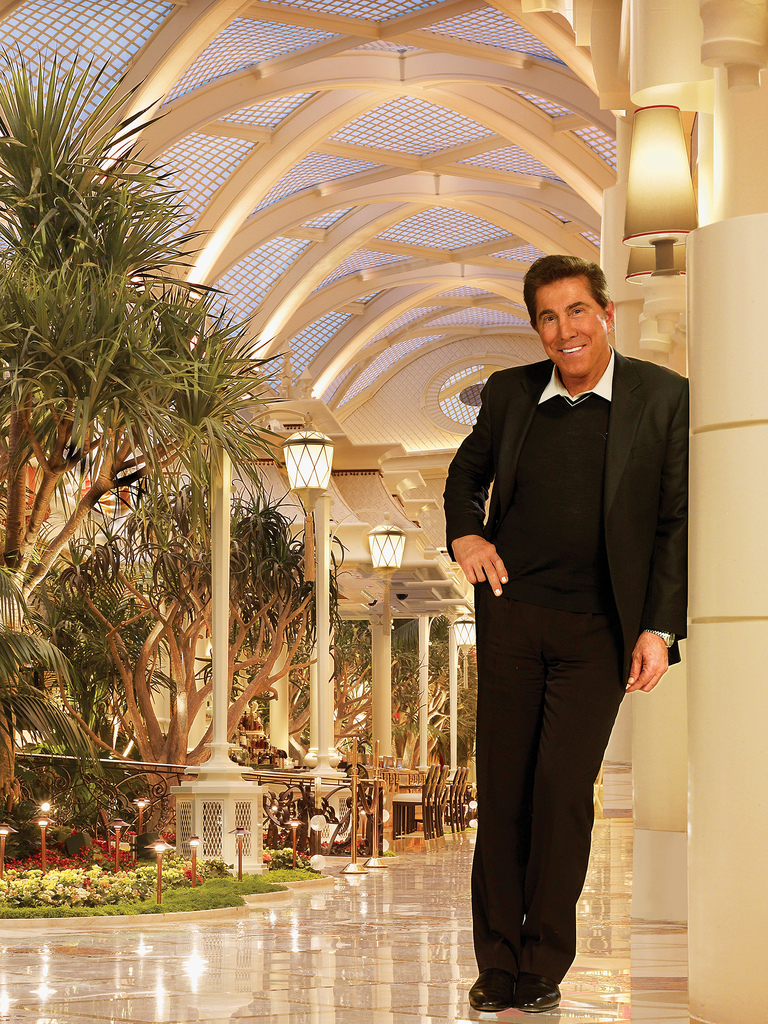 The
dynamic began to change in 2005 when
master entrepreneur Steve Wynn (left),
having sold Bellagio, opened Wynn Las
Vegas, where he was adamant that there be no absentee celebrity chefs;
indeed, on the properties’ websites he promises that “The stars are the
chefs . . . and in each case they cook your dinner, bake your bread,
and prepare your pastries every day themselves, except for their
occasional days off.”
The
dynamic began to change in 2005 when
master entrepreneur Steve Wynn (left),
having sold Bellagio, opened Wynn Las
Vegas, where he was adamant that there be no absentee celebrity chefs;
indeed, on the properties’ websites he promises that “The stars are the
chefs . . . and in each case they cook your dinner, bake your bread,
and prepare your pastries every day themselves, except for their
occasional days off.”
Wynn had already brought the great Spanish
chef Julian Serrano to move to town and become the star chef who
cooks—brilliantly--each night at Picasso at Bellagio, one of the most
sumptuous high-end French restaurants in the city, as well as
convincing the Maccioni family of New York’s illustrious Le Cirque to
send their son Mario to oversee the superb Le Cirque and Circo
restaurants in the hotel.
After selling Bellagio and opening Wynn Las
Vegas, he brought in Alessandro
Stratta to Alex, a
sumptuous dining room with a grand staircase for the
full glamor treatment. Stratta has won the James Beard Award for
Best Chef in he Southwest and has two stars from Michelin. If
you’re
feeling lucky at the tables, then the $185 tasting menu is the way to
go here, with dishes like hot-and-cold foie gras with Spanish ham,
pineapple, Brussels sprouts and spiced duck sauce; American Wagyu short
rib with gnocchi, roasted asparagus, Parmigiano and red wine; and
toasted vanilla custard with maple rhubarb and crème
fraîche ice cream.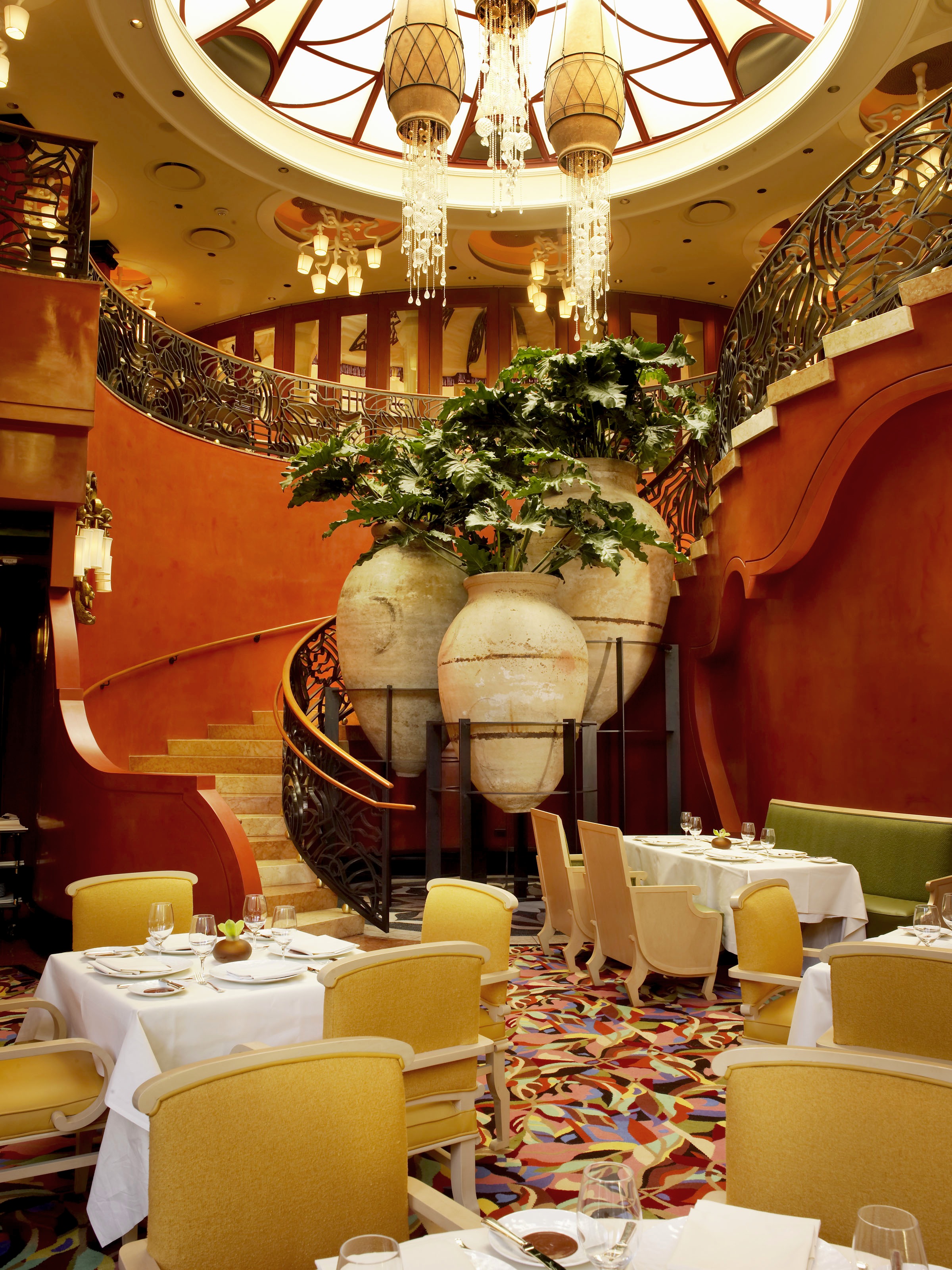
And no one is doing finer Italian
seafood than Paul Bartolotta at Bartolotta at
Wynn (right), from
glorious scamponi (Sicilian
langoustines) and cicala di mare (slipper lobster),
and moleche (tiny Venetian crabs)—all expensive but priceless. He
combines fresh porcini mushrooms with seared sea scallops, and his frittura of fried fish
is addictive, with nothing more than squirt of
lemon.
Wynn Las Vegas
was quite a departure and
a challenge to his competitors up and down the Strip to do the same.
But in upping the ante, few have took the challenge, so that
outside of Wynn’s hotels, there are few on-premises name chefs
elsewhere in town. What the other hotel/casino owners did was to
bring up the level of ultra-fine dining, again with star chefs but with
a greater overall commitment to quality and service, including Paris
imports from Michelin three-star chefs whose namesake
restaurants, Guy Savoy at Caesars Palace and Joël Robuchon at
MGMGrand and Twins Pierre Gagnaire at the Mandarin-Oriental. You
can also easily
spend in excess of $150 per person (without wine or tip) at any of
them.
Wynn raised the stakes again upon opening Wynn
Encore in December 2008, keeping to his commitment to having
on-premises name chefs while developing new styles of restaurant. Wynn
Las Vegas’ most popular restaurant is SW, a steakhouse with an aquatic
light-and-sound show just beyond its windows, while Wynn Encore’s
steakhouse is Botero
(below),
after the Colombian artist of the same
name, known for his voluptuously fat female nudes, one of which centers
the sleek, seductive and shadowy pillared dining room. They do
serve a good steak here but I was more delighted by the appetizers and
side dishes, from a lush hamachi tartare with sweet chili vinaigrette
and a plate of crispy frogs’ legs with lemon butter and fennel salad to
the truffled macaroni and cheese and curried spaetzle with fava beans.
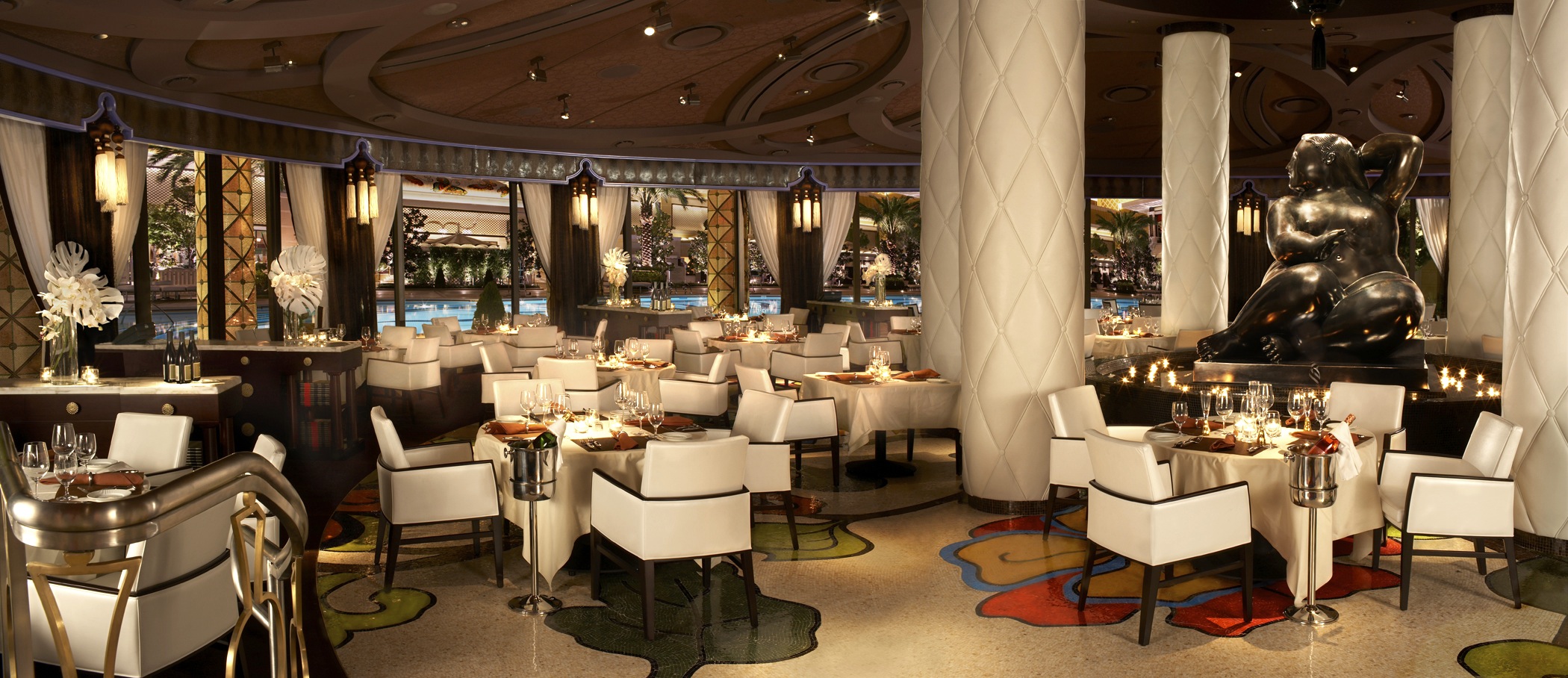 Sinatra in
Wynn Encore is one
of the newest
restaurants, though frankly (no pun intended) I had hoped I would
bowled over by a retro-cool design and menu of a kind Ol’ Blue Eyes
would have loved. The dining room does have blown-up photos of
him but little else to suggest those ring-a-ding days.
Nevertheless, Chef Theo Shoenegger has long been one of America’s
finest Italian masters, here serving upscale versions of osso buco and
pasta fagioli. Caveat emptor:
It ain't cheap.
Sinatra in
Wynn Encore is one
of the newest
restaurants, though frankly (no pun intended) I had hoped I would
bowled over by a retro-cool design and menu of a kind Ol’ Blue Eyes
would have loved. The dining room does have blown-up photos of
him but little else to suggest those ring-a-ding days.
Nevertheless, Chef Theo Shoenegger has long been one of America’s
finest Italian masters, here serving upscale versions of osso buco and
pasta fagioli. Caveat emptor:
It ain't cheap.
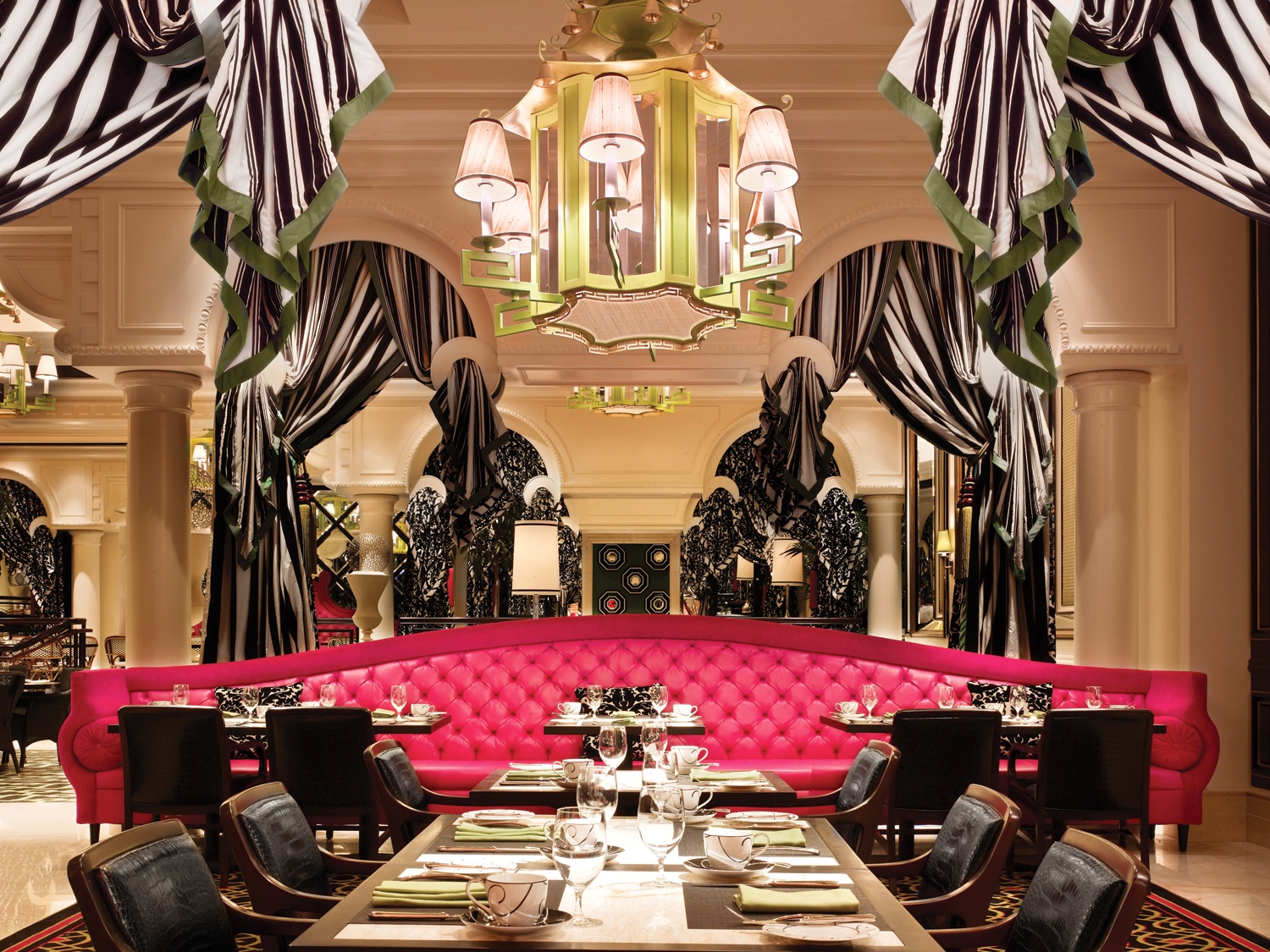 Also at Encore is Society Café
(left, below), which
has the swanky look of a Las Vegas breakfast-lunch place (though it’s
open for dinner too) but it also has some of the most delectable small
plates and comfort foods in the city, thanks to Chef Kim Cateenwalla,
who knows how to refine old favorites without too much fuss. So you get
perfect textures, first-rate ingredients, and a wow factor in dishes
like his braised pork short ribs with gnocchi and vegetable
ragoût, the “lollipop” chicken wings with blue cheese sauce,
terrific beef-and-veal meatballs with caramelized onions, tomatoes, and
horseradish sauce, and irresistible mac-and-cheese “bites” that you dip
into a fabulous truffle sauce.
Also at Encore is Society Café
(left, below), which
has the swanky look of a Las Vegas breakfast-lunch place (though it’s
open for dinner too) but it also has some of the most delectable small
plates and comfort foods in the city, thanks to Chef Kim Cateenwalla,
who knows how to refine old favorites without too much fuss. So you get
perfect textures, first-rate ingredients, and a wow factor in dishes
like his braised pork short ribs with gnocchi and vegetable
ragoût, the “lollipop” chicken wings with blue cheese sauce,
terrific beef-and-veal meatballs with caramelized onions, tomatoes, and
horseradish sauce, and irresistible mac-and-cheese “bites” that you dip
into a fabulous truffle sauce.
Among the many lavish and
not-so-lavish Chinese/Asian restaurants in Vegas, Wazuzu
(below) is the best I've
seen, skirting the overly pretentious while not in any way
treating the food as merely an ethnic alternative.
Chef Jet Tila, who is Thai, is doing Pan-Asian food here in an
open dining room off the casino floor, and it's a bright,
colorful and fairly casual place serious about its food, which ranges
from excellent sushi by Chef Masaru Matsuura, with three dozen
selections, to starters like shu
mai dumplings, hot wings, and a
fine Thai beef salad. There are several noodle offerings, and then the
special main courses, which range from miso-marinated black cod to
Korean galibi short ribs and
salt-and-pepper prawns. The prices
for this kind of quality and atmosphere are very reasonable, too, 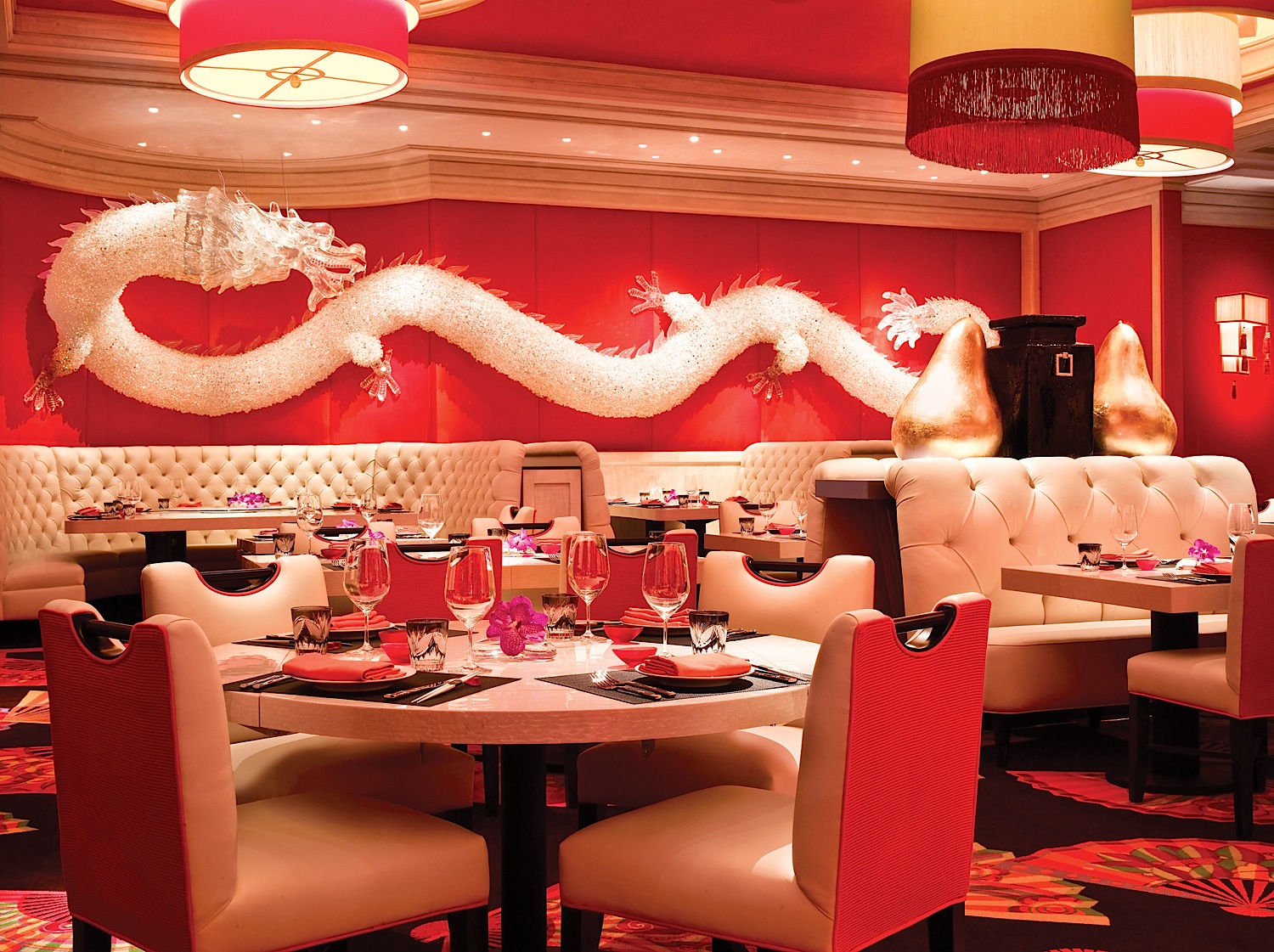 with most main courses in the mid-$20 range.
with most main courses in the mid-$20 range.
By the
way, given
the economic downturn that has affected Vegas’ business, once
impossible-to-get-into restaurants are now running on empty—some of the
biggest names are only open four nights a week--and unless there is a
huge convention in town on a weekend, you should have little trouble
scoring a table just about anywhere.
This has also had an effect
on menu prices, though you’d never know it at those few places daring
to charge $40-$50 for a main course. These days a lot of the big
steakhouses like the Palm, Morton’s, and others are featuring $39
three-course steak dinners. And then of course there are the
outrageously well-priced Vegas buffets. True, once upon a time
you paid $7.95 for all-u-can-eat, but the food was dreadful. Now
very good food of every kind—from pasta to sushi—can be found in the
best hotels: at the Bellagio, the buffet lunch runs $19.95 and dinner
$27.95 for the full gorge, and weekend Champagne brunch is $28.95.
Luxor dinner is only $19.99.
What have remained high are wine prices
in Vegas, so tell the sommelier what you wish to spend and order
accordingly.
NEW YORK CORNER
by John Mariani
Time-Warner Center, 3rd Floor
10 Columbus Circle
212-823-2523
www.avoce.com
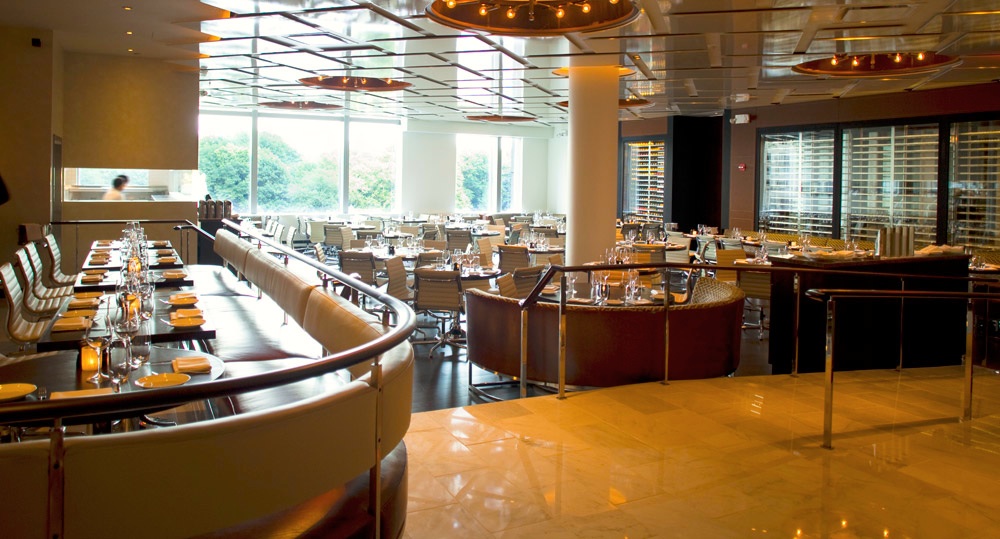 When
A Voce opened down at Madison Park three years ago, it brought rustic
Italian
food to a new level of taste, at the time under Chef Andrew Carmellini
(now partner at Locanda Verde), then under Chef Missy Robbins, who had
been Executive Chef at the great
Spiaggia in Chicago for five years, and before that at top New
York restaurants like March, Arcadia and The Lobster Club, and a
stint at Agli Amici in Friuli. In my article about her appointment this
year, I wrote, "Robbins has translated all that learning into her
menus at A Voce, which do not attempt to replicate Carmellini's dishes
but continue his legacy of bold, gutsy Italian food." Now, under
the umbrella of the MARC restaurant group, Robbins has opened a second
front, uptown at the Time Warner Center, in the space that had been the
failed Café
Gray.
When
A Voce opened down at Madison Park three years ago, it brought rustic
Italian
food to a new level of taste, at the time under Chef Andrew Carmellini
(now partner at Locanda Verde), then under Chef Missy Robbins, who had
been Executive Chef at the great
Spiaggia in Chicago for five years, and before that at top New
York restaurants like March, Arcadia and The Lobster Club, and a
stint at Agli Amici in Friuli. In my article about her appointment this
year, I wrote, "Robbins has translated all that learning into her
menus at A Voce, which do not attempt to replicate Carmellini's dishes
but continue his legacy of bold, gutsy Italian food." Now, under
the umbrella of the MARC restaurant group, Robbins has opened a second
front, uptown at the Time Warner Center, in the space that had been the
failed Café
Gray.First thing MARC did was to remove the kitchen from the glorious window space overlooking Columbus Circle and Central Park and put the brigade behind glass, allowing guests to enjoy that view from swiveling
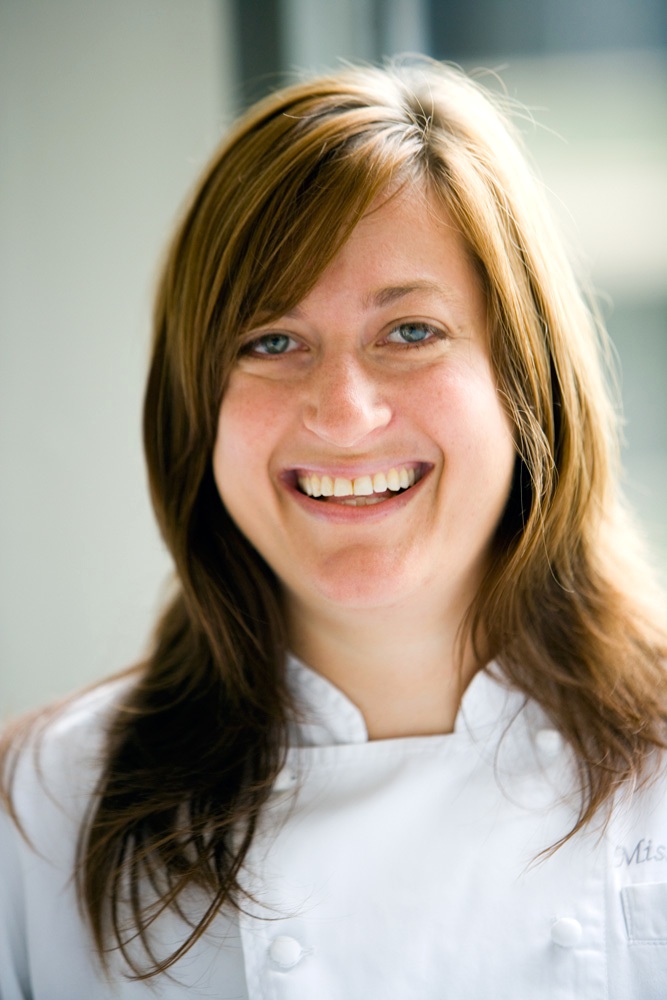 chairs beneath a mirror-like
ceiling. The place sparkles at lunchtime and gets shadowy at
dinner, with a noise level that edges towards the high decibels.
As I so often do, I would heartily recommend adding white tablecloths
at night--the tops are now black composite--which would both brighten
the
atmosphere and tamp down the noise.
chairs beneath a mirror-like
ceiling. The place sparkles at lunchtime and gets shadowy at
dinner, with a noise level that edges towards the high decibels.
As I so often do, I would heartily recommend adding white tablecloths
at night--the tops are now black composite--which would both brighten
the
atmosphere and tamp down the noise.There are similarities in the menus downtown and uptown, always reflecting the lusty side of modern cucina alla italiana. You should always begin with a selection of fine charcuterie--the beef carpaccio with walnuts and pecorino; the various salumi; and above all the 'nduja, a very hot, peppery condiment you spread on toast.
For pastas, you won't go wrong anywhere on the primi menu, at least not if you order the terrific pici, hand-rolled pasta with Brussels sprouts, bacon, almonds, and whipped sheep's milk. The ravioli filled with goat's cheese and prosciutto is outstanding, with sweet leeks and pistachios. Only by comparison did ricotta gnocchi with zucchini, squash blossoms, and mint seem somewhat bland, despite the presence of saline bottarga roe.
If you wish to stay simple with your main course I highly recommend the pollo alla mattone--a dish you see elsewhere, chicken flattened with "a brick" or other weight, and grilled--but at A Voce marinating of the chicken in fennel and chili and the side of Tuscan greens, gigante white beans, and Yukon gold potatoes makes
 this a sumptuous
dish. A massive pork chop is served with roasted abalone
mushrooms, arugula, and assertive grilled lemons, while brasato, that
triumph of paisan cookery, was a plate of beef braised in red wine and
served with farro, root vegetable, and the richness of bone marrow.
this a sumptuous
dish. A massive pork chop is served with roasted abalone
mushrooms, arugula, and assertive grilled lemons, while brasato, that
triumph of paisan cookery, was a plate of beef braised in red wine and
served with farro, root vegetable, and the richness of bone marrow.It's hard to pass up the selection of wonderful cheeses with condiments (left) here, so don't: have a plate and let the rest of your table order desserts to share, like the panna cotta with Meyer lemon and a hint of thyme or the espresso-chocolate tart with toasted almonds and cocoa nibs. But do try the crespelle, ricotta-filled thin pancakes with roasted apples and rum-raisin sauce--as good a dolce as you'll find this winter.
Wine director Olivier Flosse stocks one of the best Italian lists in the city, of which more than half are under $90--still a high break point, but there really are plenty of fine regional wines under $50 too.
A Voce has made the leap to the third floor of Time Warner very successfully and for all the right reasons for right now: It's not a starchy place, it's got a great view, the food leaves everyone satisfied, it's priced right, and Missy Robbins is in charge. What more can you ask?
A Voce is open for lunch Mon.-Fri, for dinner nightly, and brunch Sat. & Sun. Antipasti run $10-$16, pastas as full portions $17-$25, and main courses $28-$38. There is a prix fixe lunch at $29 and pre-theater dinner at $35.
NOTES
FROM THE WINE CELLAR
A
HARLAN DINNER FOR THE AGES
by Brian A. Freedman
Photos by Paul Kellerhals
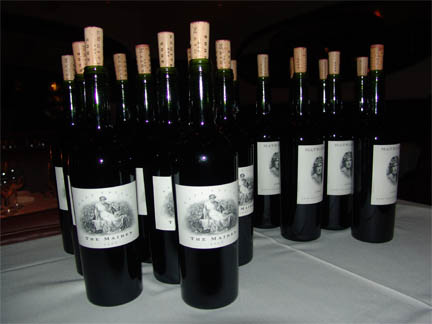
But that’s exactly what Harlan set out to do, and now, all these years later, it is generally a foregone conclusion that his eponymous wine ranks among the top tier in America--and, indeed, the world.
Which is why the prospect of my flying cross-country for a wine dinner of this caliber was perfectly logical: Celebrating the 25th anniversary of an estate that has arguably done as much to raise the reputation of American wine, and change perceptions of what we are capable of on this side of the Atlantic, as any other, was not to be missed.
In general, the great wines of the world tend to share a number of important characteristics in common: They express a unique, often idiosyncratic terroir with clarity and honesty; they are produced from top-quality fruit and through fastidious winemaking; they have the potential to evolve over the years into something far more nuanced and elegant than their youth tends to express (but which is typically implied early on); and they do all this year after year, slowing building up what might be called an edifice of reliability, ever-growing complexity, and stylistic character.
But there are also a number of non-vinous characteristics that the great wines of the world share, and most of these are based in the unique philosophy that is ultimately the wellspring of their creation. For Bill Harlan, he knew exactly what the guiding philosophy of his estate would be from the beginning: It would be a family affair, rooted firmly in the land and created with an eye toward being carried on even after he no longer has a hand in it.
Businesses that have succeeded for two or three hundred years have three things in common, Harlan pointed out during the dinner. They are based on the land, remain family-owned, and carry no debt. A family, he explained, can pass a culture on from generation to generation, slowly improving without having to worry about quarterly earnings. This, in turn, affords them the opportunity to pursue their goals with more freedom, even if the process of achieving them relies more on long-term effort than short.
With that in mind, he told me, he is trying to instill in his family the importance of the land, his philosophy, and the meaning that Harlan Estate holds for the future.
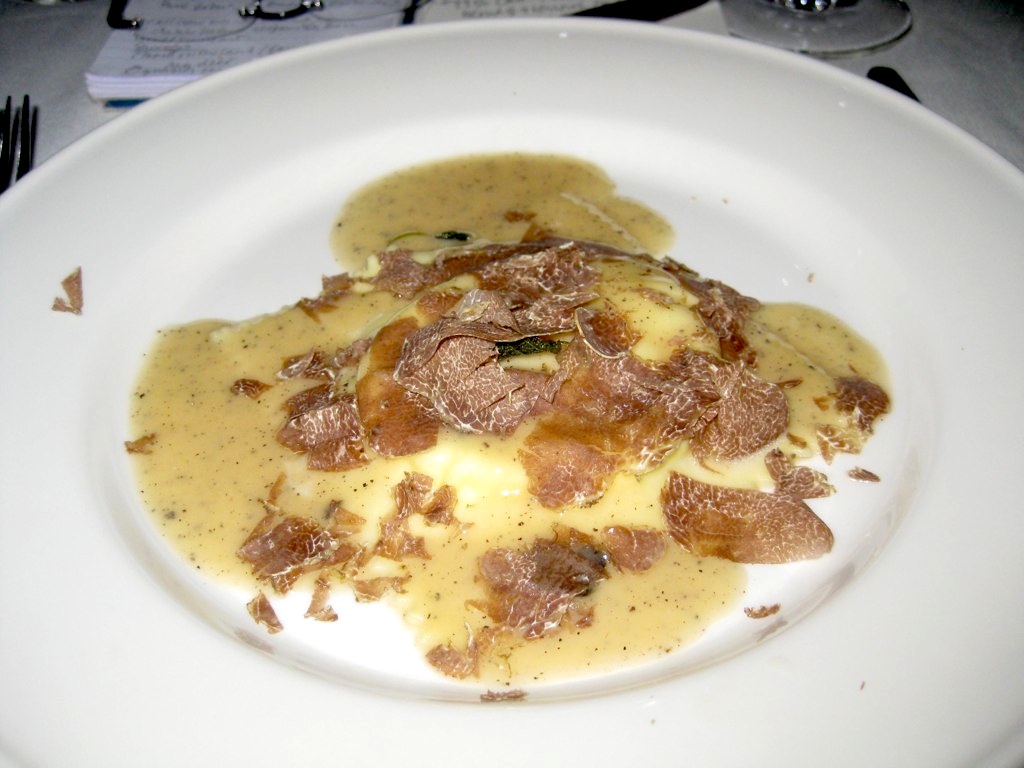 The
Harlan Estate 25th anniversary dinner, held at the excellent Italian
restaurant Poggio in Sausalito, provided the rare opportunity not only
to taste a number of Harlan’s wines but to do so alongside beautifully
prepared, thoughtfully paired food. The dinner was hosted by Larry
Mindel, Poggio’s owner; Peter McNee, its acclaimed executive chef and
partner; and the James Beard Foundation, represented by its
president Susan Ungaro, which benefited from the auction that took
place that night.
The
Harlan Estate 25th anniversary dinner, held at the excellent Italian
restaurant Poggio in Sausalito, provided the rare opportunity not only
to taste a number of Harlan’s wines but to do so alongside beautifully
prepared, thoughtfully paired food. The dinner was hosted by Larry
Mindel, Poggio’s owner; Peter McNee, its acclaimed executive chef and
partner; and the James Beard Foundation, represented by its
president Susan Ungaro, which benefited from the auction that took
place that night.The Maiden 2005 and Matriarch 2005 led off the meal, paired with a fabulously earthy spit-roasted squab, a tender preparation that highlighted the gaminess of the bird through a generous application of shaved black truffle, well-considered house-cured lardo wrapped around the rare breast, and red wine- and squab stock-braised cipollini whose sweet-savoriness actually threw the earthy notes of the dish into even sharper relief, accompanied by a lovely crêpinette and mushroom farro. The Maiden sang with dark, lush berry fruit that really came to the fore when sipped after a bite of lardo-wrapped breast. Even before sampling the food, it showed incredible structure, rich currant and blackberry fruit, notes of fresh asphalt, and a touch of tobacco.
The Matriarch, on the other hand, was more chocolatey on the mid-palate, its subtle, lush texture lifted by notes of mint, spice, and tobacco. Both of the wines have long lives ahead (a decade or more, surely), yet are wonderful right now with enough time in the decanter.
(NB: All of the wines served at the dinner had been double-decanted, between 2:45 and 6:30 that day, by Wine Director Gregory Altzman.)
Next came a single raviolo (above), filled with a tongue-coating, seasoned ricotta, itself topped with a hen yolk before being sealed, all of it plated with brown butter, sage, and enough shaved white truffles to make your average Piedmontese blush; for me, this was the best wine pairing of the night--a magnum of BOND Vecina 1999 that lifted the truffle flawlessly with its fresh aromas of anise and licorice. The palate just exploded with unexpected flashes of sesame, black bean sauce, melted licorice, and an expansive depth that continued to grow throughout the finish. Despite all that, it still maintained a sense of linearity, a core of richness that promises years of further evolution in the bottle.
Straccoto, red wine-braised short rib and oak-grilled strip steak with porcini, veal jus, and a red wine and marrow butter, were paired with both the Harlan 2000 (the most Bordeaux-like wine of the evening) and the 2004. The former, from a cooler year that winemaker Bob Levy explained made it a bit more approachable, showed an almost Pauillac-like character of soft mushroom notes, sous bois, crushed purple fruits, and excellent acidity. It coated the inside of the mouth and continued to evolve in the glass, picking up hints of caramelized wild strawberries, blackberries, eucalyptus, rich dark cherry, kirsch, and cocoa powder. Poggio owner Larry MIndel and Bill Harlan
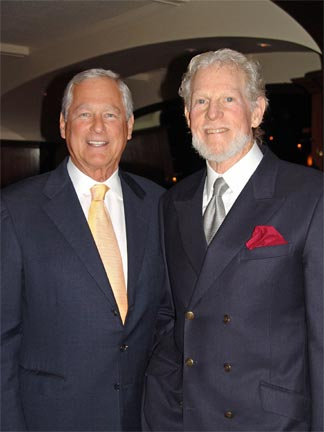
Levy described the 2004, on the other hand, as possessing more classic Napa richness and power. It’s still young, though, and if I had a bottle in my own collection, I’d find myself conflicted over whether to open it in the next five years or to hold off until it’s a bit more mature. As it stands now, the 2004 looks to have another 15 or more years of evolution left, though at the dinner, with the benefit of double-decanting, it showed magnificent notes of mint, cigar tobacco, and grilled dark berry fruit, all of it wrapped up in a structure that allowed it to carry on for a 45-second-plus finish.
The final wine of the night, paired with a Castelmagno cheese soufflé and vin santo-preserved figs, was the Harlan 1997, a legendary bottling and easily one of the best wines I’ve ever tasted--can I give a wine more than 100 points?-- an explosive, palate-coating, almost Port-like mouthful of figs, raisins, scorched earth, and dark sweet cherries. Despite all this richness, though, there was an undeniable sense of place, an exuberance that only could have come from Napa. The perfume of cinnamon, clove, and other warm brown spices wafted up from the glass, the texture such that I had to resist the urge to chew it, and the finish, perfectly balanced, lasted for at least a minute, lingering on with characteristics of sun-warmed wild strawberries, hoisin, and black bean sauce. Even at 12 years of age, it remained remarkably youthful, both magnificent right now and, like the rest of the bottles poured at the dinner, promising a long life ahead.
First Growth quality, no question--just like Harlan set out to do all those years ago.
Brian Freedman is a food and wine writer, wine educator, and food and wine consultant. He is Director of Wine Education for the Wine School of Philadelphia, contributing editor for Philadelphia Style Magazine, wine columnist for Affluent Magazine, and writes the blog www.UncorkLife.com for www.WineChateau.com. His web site is www.BrianFreedmanPhiladelphia.com.
`````````````````````````````````````````````
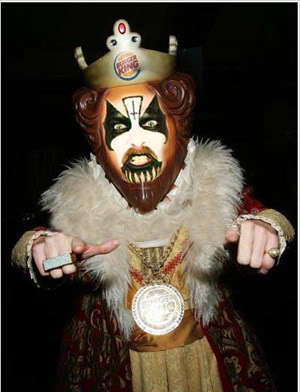
BUN-ZAI!
Burger King in Tokyo has introduced the spicy "Angry Whopper" with jalapeño peppers, hot sauce, onions, cheese, bacon, tomatoes and lettuce by holding a shouting contest that allows pedestrians to scream their aggression away, such as, "I need to get a girlfriend" and "Professor, give me my credits."
DEPARTMENT OF TOO MUCH HONESTY
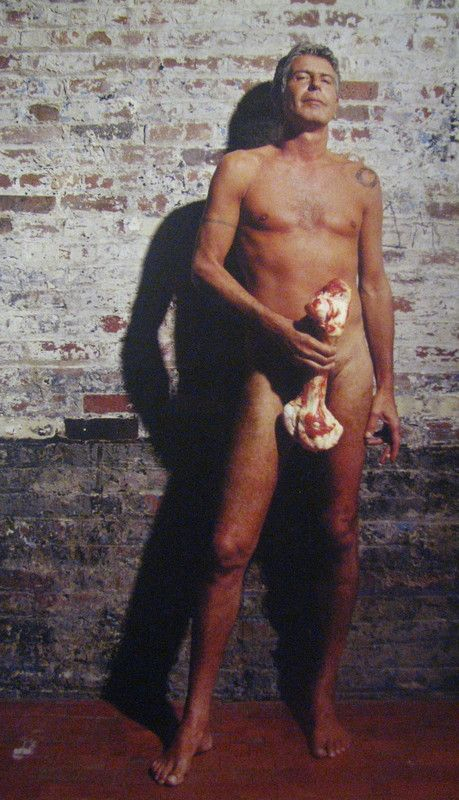
Q: In your book "The Nasty Bits," there's an essay in which you state that you would rather put "habitual masturbator" on a visa application than "television personality." You are now six years into "No Reservations." Do you feel more comfortable with the role?
Anthony Bourdain: Nah, not really. It still feels sort of shameful. It's easy work. I know what work is. My expectations of what work is, my concept of work or a profession was formed by 28 years of standing on my feet really working. . . . Television personality just doesn't sound like a job to me. . . . So, I'll live with celebrity chef, or television personality, but in my heart of hearts, I'd put it on the same level as lighting director on porn film, habitual masturbator, or aspiring arsonist."--Interview with Anthony Bourdain by James Leach, City BNewspaper (11/18/09).
~~~~~~~~~~~~~~~~~~~~
✉ Guidelines for submissions: QUICK BYTES publishes only events, special dinners, etc, open to the public, not restaurant openings or personnel changes. When submitting please send the most pertinent info, incl. tel # and site, in one short paragraph as simple e-mail text, WITH DATE LISTED FIRST, as below. Thanks. John Mariani
IMPORTANT NOTE: Owing to
the number of Christmas holiday and New Year's announcements received, QUICK
BYTES cannot
publish any but a handful of the most unusual.
*On Dec. 9 in NYC,
El Café at El
Museo del Barrio, presents guest chef Scott Gottlich of Dallas’ Bijoux
Restaurant, serving up Southwestern dishes including Garbanzo Bean
Soup, Stewed Lamb Leg with poblano chile, Zamorano with Piquillo pepper
and chorizo and Mexican Wedding Cookies. The menu will be
available from Dec. 9-13. Call 212-831-7272.
* On Dec. 14 in Brooklyn, NY, Bark Hot Dogs will host a special hot dog and sparkling wine pairing event. This guided 5-course dinner will feature both regular and gourmet wieners, each paired with one of Gruet Winery’s multi-award-winning sparkling wines made by the traditional champagne method. Tickets are $30 pp. Call 718-789-1939 or email bark@barkhotdogs.com.
* On Dec. 15 in NYC, The Gohan Society Lecture Series & Demonstration at The French Culinary Institute will feature Chef Toshio Suzuki of Sushi Zen, who will demonstrate a tasting, comparing taste and texture according to the elapsed time after ike-jime, a Japanese fish killing technique. To RSVP email: Taeko@gohansociety.org.
* On Dec. 17, in Riverside, IL, The Chew Chew Restaurant will warm up the holiday season with its SPANISH WINE DINNER WEEK, featuring 5 courses of Spanish wine & food. $55 pp.Call 708-447-4781 or visit www.thechewchew.com.
* From Dec. 21-24 in Chicago, Nacional 27 will present its annual
Cuban holiday prix-fixe menu, a four-course, family-style dinner paired
with wines. $45 pp. Call 312-664-2727;
www.n27chicago.com.
~~~~~~~~~~~~~~~~~~~~~~~~~~~~
Everett Potter's Travel Report:

~~~~~~~~~~~~~~~~~~~~~~~~~~~~~~~~~~~~~~~~~~~~~~~~~~~~~~~~~~~~~~~~~~~~~~~~~~
Eating Las Vegas is the new on-line site for Virtual Gourmet contributor John A. Curtas., who since 1995 has been commenting on the Las Vegas food scene and reviewing restaurants for Nevada Public Radio. He is also the restaurant critic for KLAS TV, Channel 8 in Las Vegas, and his past reviews can be accessed at KNPR.org. Click on the logo below to go directly to his site.
~~~~~~~~~~~~~~~~~~~~~~~~~~~~~~~~~~~~~~~~~~~~~~~~~~~~~~~~~~~~~~~~~~~~~~~~~~~
Tennis Resorts Online: A Critical Guide to the World's Best Tennis Resorts and Tennis Camps, published by ROGER COX, who has spent more than two decades writing about tennis travel, including a 17-year stretch for Tennis magazine. He has also written for Arthur Frommer's Budget Travel, New York Magazine, Travel & Leisure, Esquire, Money, USTA Magazine, Men's Journal, and The Robb Report. He has authored two books-The World's Best Tennis Vacations (Stephen Greene Press/Viking Penguin, 1990) and The Best Places to Stay in the Rockies (Houghton Mifflin, 1992 & 1994), and the Melbourne (Australia) chapter to the Wall Street Journal Business Guide to Cities of the Pacific Rim (Fodor's Travel Guides, 1991).

Family Travel
Forum: The
Family Travel Forum (FTF), whose motto is "Have Kids, Still Travel!",
is dedicated to the ideals, promotion and support of travel with
children. Founded by business professionals John Manton and Kyle
McCarthy with first class travel industry credentials and global family
travel experience, the independent, family-supported FTF will provide
its members with honest, unbiased information, informed advice and
practical tips; all designed to make traveling a rewarding, healthy,
safe, better value and hassle-free experience for adults and children
who journey together. Membership in FTF will lead you to new worlds of
adventure, fun and learning. Join the movement.
All You Need to Know Before You Go
nickonwine: An engaging, interactive wine column by Nick Passmore, Artisanal Editor, Four Seasons Magazine; Wine Columnist, BusinessWeek.com; nick@nickonwine.com; www.nickonwine.com.

MARIANI'S VIRTUAL GOURMET NEWSLETTER is published weekly. Editor/Publisher: John Mariani.
Contributing Writers: Robert Mariani,
John A. Curtas, Edward Brivio, Mort
Hochstein, Suzanne Wright, and Brian Freedman. Contributing
Photographers: Galina Stepanoff-Dargery, Bobby Pirillo. Technical
Advisor: Gerry McLoughlin.
Any of John Mariani's books below
may be ordered from amazon.com by clicking on the cover image.
 My
newest book, written with my brother Robert Mariani, is a memoir of our
years growing up in the My
newest book, written with my brother Robert Mariani, is a memoir of our
years growing up in the For those of you who don't think of the Robert and I think you'll enjoy this very personal look at our --John Mariani |
 |
 |
 |
 |
 |
 |
© copyright John Mariani 2009
